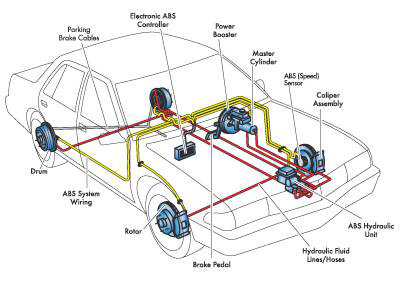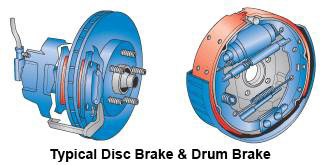Car Care - About Brakes
Your vehicle’s brake system has one job – to stop your vehicle. But it takes several key components to deliver that singular end result.

To bring a vehicle to a halt, three things are necessary: leverage, hydraulic force and friction. Leverage is supplied by the driver’s leg pressure and the brake pedal. The pedal is connected by levers and rods to the back of the power booster. The power booster uses either engine vacuum or a hydraulic pump to multiply and transfer the force of that leverage to the master cylinder. The master cylinder is the heart of your vehicle’s brake hydraulic system. It uses applied leverage to force a reservoir full of brake fluid through valves, steel lines and rubber hoses into hydraulic calipers and wheel cylinders. That hydraulic pressure is then used to help create friction.
For example, disc brakes use a hydraulic caliper fitted with brake pads to grab a spinning disc (or rotor). Drum brakes, on the other hand, have a hydraulic wheel cylinder that pushes a brake shoe against the inside of a spinning drum. Either design involves highly engineered parts and precise movement. The more force a driver applies to the brake pedal, the greater the stopping force that is applied at the wheels.

In addition to this primary braking system, most of today’s vehicles utilize an electronic Anti-lock Brake System. Using electronic sensors and high pressure pumps, under certain conditions, your ABS system can measure vehicle speed, wheel slip, and brake force. Then it actually pumps the brakes for you during an emergency stop.
That’s why it is essential to be proactive about testing overall brake components, and to know whether a brake component needs simply to be serviced or totally replaced.
What to Watch for
When brakes need a mechanic's attention, they usually give certain warning signals.
Common Signs of Wear
- A low or spongy pedal, which can mean there may be air in the hydraulic system
- A red brake-warning light that could indicate an imbalance in the system
- An amber brake-warning light that could signal a problem with the ABS system
- Continuous squeals and grinding sounds – may mean it’s time for new brake pads or shoes
- Brake pad and rotor thickness – worn pads or rotors that are too thin cannot dissipate the extreme heat produced during braking
- Brake shoe and drum diameter – worn shoes or drums not only dissipate less heat, they can cause your brake pedal to be pushed further to the floor to make your vehicle stop
- Shaking felt in your brake pedal when slowing from higher speeds- warped brake rotors due to extreme heat during braking
These conditions can cause longer stopping distances and difficult stopping in an emergency situation. Rotors and drums that are too thin may even become over-stressed and break. Remember, any time you notice any one of these or a combination of these symptoms, it's a good idea to have the brakes checked. In fact, we recommend that you have them inspected on a regular basis.